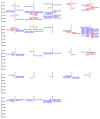Genomic Regions Associated with Resistance to Gastrointestinal Nematode Parasites in Sheep-A Review
- PMID: 38397178
- PMCID: PMC10888242
- DOI: 10.3390/genes15020187
Genomic Regions Associated with Resistance to Gastrointestinal Nematode Parasites in Sheep-A Review
Abstract
Gastrointestinal nematodes (GINs) can be a major constraint and global challenge to the sheep industry. These nematodes infect the small intestine and abomasum of grazing sheep, causing symptoms such as weight loss, diarrhea, hypoproteinemia, and anemia, which can lead to death. The use of anthelmintics to treat infected animals has led to GIN resistance, and excessive use of these drugs has resulted in residue traced in food and the environment. Resistance to GINs can be measured using multiple traits, including fecal egg count (FEC), Faffa Malan Chart scores, hematocrit, packed cell volume, eosinophilia, immunoglobulin (Ig), and dagginess scores. Genetic variation among animals exists, and understanding these differences can help identify genomic regions associated with resistance to GINs in sheep. Genes playing important roles in the immune system were identified in several studies in this review, such as the CFI and MUC15 genes. Results from several studies showed overlapping quantitative trait loci (QTLs) associated with multiple traits measuring resistance to GINs, mainly FEC. The discovery of genomic regions, positional candidate genes, and QTLs associated with resistance to GINs can help increase and accelerate genetic gains in sheep breeding programs and reveal the genetic basis and biological mechanisms underlying this trait.
Keywords: candidate genes; gastrointestinal nematodes; genome-wide association study; genomics; quantitative trait loci; sheep.
Conflict of interest statement
The authors declare no conflicts of interest.
Figures

References
-
- Karrow N.A., Goliboski K., Stonos N., Schenkel F., Peregrine A. Review: Genetics of Helminth Resistance in Sheep. Can. J. Anim. Sci. 2014;94:1–9. doi: 10.4141/cjas2013-036. - DOI
-
- Miller J.E., Kaplan R.M., Pugh D.G. Sheep and Goat Medicine. Elsevier; Amsterdam, The Netherlands: 2012. Internal Parasites; pp. 106–125.
-
- Kaplan R.M., Burke J.M., Terrill T.H., Miller J.E., Getz W.R., Mobini S., Valencia E., Williams M.J., Williamson L.H., Larsen M., et al. Validation of the FAMACHA Eye Color Chart for Detecting Clinical Anemia in Sheep and Goats on Farms in the Southern United States. Vet. Parasitol. 2004;123:105–120. doi: 10.1016/j.vetpar.2004.06.005. - DOI - PubMed
Publication types
MeSH terms
Grants and funding
LinkOut - more resources
Full Text Sources
Miscellaneous

